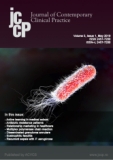Eosinophilic fasciitis associated with factor V Leiden: a case report
Eosinophilic fasciitis associated with factor V Leiden: a case report
Author(s): Mihaela Antohe, Mihaela Balaban, Ani Grecu, Andra Postelnicu, Răzvan Theodor Andrei, Sabina Zurac, Gabriela TurcuSubject(s): Health and medicine and law, Present Times (2010 - today)
Published by: Asociația pentru Creșterea Vizibilității Cercetării Științifice (ACVCS)
Keywords: eosinophilia; fasciitis; factor V Leiden;
Summary/Abstract: Introduction Eosinophilic fasciitis is a sclerodermiform syndrome with the histopathologic hallmark of fascial fibrosis. The following have been suggested as potential triggers: physical exercise, trauma, Lyme disease, hematologic malignancies, thyroid diseases, hemodialysis, systemic lupus erythematosus and exposure to certain medications such as: statins, L-tryptophan, phenytoin, ramipril or subcutaneous heparin. Case report We report the case of a 75-year-old man with sclero-indurative, alopecic and shiny skin affecting almost the entire body (with the exception of face, perigenital area, hands and feet), “groove sign” at the upper extremities and impaired mobility of ankles, knees and elbows, evolving for almost 8 months. At the thigh level he presented a net-like vascular pattern suggestive for livedo reticularis. Clinical evaluation, laboratory studies and pathological examination established the diagnosis of eosinophilic fasciitis associated with factor V Leiden. Discussion Eosinophilic fasciitis is a rare disease that needs to be differentiated from localized and systemic sclerosis, scleroderma-like disorders such as nephrogenic systemic fibrosis, scleromyxedema, scleredema and eosinophilia myalgia syndrome. Early diagnosing enables screening for diseases commonly reported as being associated. Up to 10 percent of patients with eosinophilic fasciitis associate hematologic abnormalities and prompt treatment can prevent long lasting sequelae. Conclusion We have presented a case of eosinophilic fasciitis and livedo reticularis caused by mutated factor V of coagulation, an association that has not been described before.
Journal: Journal of Contemporary Clinical Practice
- Issue Year: 5/2019
- Issue No: 1
- Page Range: 36-39
- Page Count: 4
- Language: English

